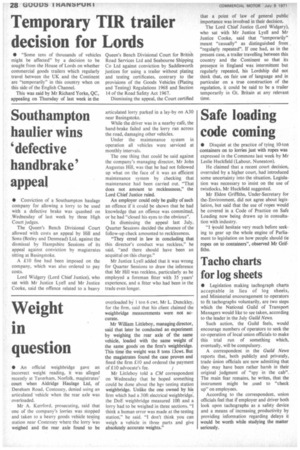Weight in question
Page 30

If you've noticed an error in this article please click here to report it so we can fix it.
• An official weighbridge gave an incorrect weight reading, it was alleged recently at Taverham. Norfolk. magistrates' court when Aldridge Haulage Ltd, of Dereham Road, Costessey, denied using an articulated vehicle when the rear axle was overloaded.
Mr A. Kerrford, prosecuting, said that one of the company's lorries was stopped and taken to a heavy goods vehicle testing station near Costessey where the lorry was weighed and the rear axle found to be overloaded by 1 ton 6 cwt. Mr L. Dunekley, for the firm, said that his client claimed the weighbridge measurements were not accurate.
Mr William Littleboy, managing director, said that later he conducted an experiment by weighing the rear axle of the same vehicle, loaded with the same weight of the same .goods on the firm's weighbridge. This time the weight was 8 tons 13cwt. But the magistrates found the case proven and fined the firm £10 and ordered the payment of £10 advocate's fee.
Mr Littleboy told a CM correspondent on Wednesday that he hoped something could be done about the hgv testing station weighbridge. Unlike the one owned by his firm which had a 30ft electrical weighbridge, the DoE weighbridge measured 10ft and a lorry had to be weighed in three sections. "I think a human error was made at the testing station'," he said. "1 don't think you can weigh a vehicle in three parts and give absolutely accurate weights."












































































































































